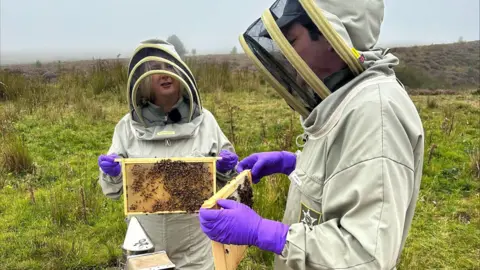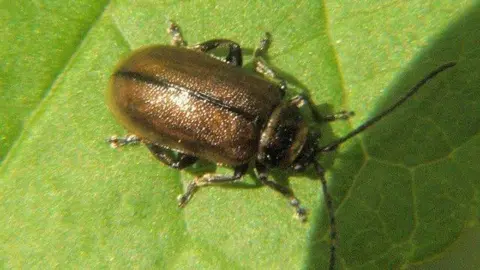In a troubling turn of events for beekeepers in the north-east of England, the supply of what is typically a premium and high-volume honey has come to a grinding halt. A worrying surge in the population of the heather beetle, a pest known for its insatiable appetite for the heather plant, has been identified as the culprit. This small insect has devastated the moorland habitat, stripping the plants of their flowers and, in the process, eliminating the crucial nectar source for bees. One producer, the Northumberland Honey Company, reports that its usual annual output of five to ten tonnes of heather honey has plummeted to zero. This “worrying hit” not only poses a significant financial challenge for beekeepers but also highlights a larger ecological vulnerability, as the country’s precious moorland habitats face a myriad of threats exacerbated by a warming climate.
The Culprit and Its Impact: A Tiny Pest with a Huge Appetite
The culprit behind the sudden collapse of heather honey production is a small but devastating pest known as the heather beetle, or Lochmaea suturalis. According to beekeepers in the north-east of England, the population of this insect has seen a worrying increase, a phenomenon linked directly to warmer weather conditions. The Heather Trust, an organization dedicated to the protection of moorland, explains that these warmer temperatures are allowing the beetles to lay more larvae on the stems of the heather plants. As these larvae develop, they go on to ruthlessly strip the plants of their flowers, leaving behind only barren stalks.

The consequences of this beetle-led rampage have been immediate and catastrophic for honey producers. The Northumberland Honey Company, which operates hives on the affected moorland in Acton, reports that its heather honey production for the year has been reduced to an unprecedented zero. This is a monumental loss for the company, which typically relies on the heather harvest for its largest and most valuable crop of the year. The beekeeper, Luke Hutchinson, describes this as a “big and worrying hit” to their business. With their primary source of one of the most premium and significant honeys stifled by the pest, beekeepers are facing a significant economic blow and a stark reminder of the fragile nature of their livelihoods in the face of ecological shifts.
A Significant and Worrying Hit to a Premium Product
The economic fallout from the heather beetle’s proliferation is particularly severe because of the unique value and importance of heather honey. Beekeepers like Luke Hutchinson consider it one of the most significant and premium honeys they can produce, often commanding a higher price due to its distinct flavor, texture, and rarity. It is also a high-volume product, typically forming the biggest part of their annual yield. For many producers in the region, the heather harvest is the last and most anticipated crop of the year, bringing in a significant portion of their revenue. The complete loss of this crop, therefore, is not just a minor inconvenience but a major commercial hit that jeopardizes the financial stability of honey producers.

This reliance on a single, specific plant for such a vital part of the business model underscores the vulnerability of beekeeping to environmental and ecological changes. Mr. Hutchinson’s candid admission that the heather beetle is “stifling that” entire production chain speaks to the unmanageable nature of the infestation. It highlights a critical point: while honeybees themselves face well-documented threats like disease and habitat loss, the entire industry is also susceptible to the health of the very plants they depend on. The heather beetle’s unchecked proliferation has effectively severed this link, leaving the beekeepers with no crop to harvest and a significant hole in their annual income.
Moorland at Risk: A Broader Environmental Crisis
The issue of the heather beetle’s proliferation extends far beyond the impact on honey production; it is a symptom of a much broader and more concerning environmental crisis affecting Britain’s moorland habitats. Katrina Candy, the director of the Heather Trust, a body dedicated to protecting these vital landscapes, warns that the country is losing vast swathes of moorland at an “alarming rate.” She puts this loss in a stunning and sobering perspective, stating that “the equivalent of the city of Birmingham is lost every year.” This catastrophic habitat destruction is disastrous for the diverse ecosystems that rely on these unique environments.
The destructive actions of the heather beetle exacerbate this problem. By stripping the flowers and eating the plants, the insects also contribute to the drying out of the land. This makes the moorland significantly more susceptible to wildfires, a risk that is already heightened by warmer, drier weather conditions. The loss of the heather’s natural protective cover can transform these landscapes into tinderboxes, posing a serious threat to local communities, wildlife, and even the air quality. The beekeepers’ struggles with honey production, therefore, serve as a potent early warning sign of a much larger ecological issue that requires urgent attention and coordinated action to protect these indispensable and fragile moorland habitats.
Mitigation and Future Prospects: A Call for Action

While the challenges posed by the heather beetle are significant, experts believe that proactive measures can be taken to manage the pest’s population and protect the moorland. Katrina Candy of the Heather Trust suggests a multi-pronged approach that combines traditional land management techniques with more innovative biological controls. One such method involves using special cutting techniques to manage the heather growth. This can help to disrupt the beetle’s life cycle and reduce the number of stems available for them to lay their eggs.
Another classic management technique is controlled burning, a practice that has been used for centuries to rejuvenate heather moorland. By strategically burning small patches, land managers can remove old, woody growth and create new, healthy growth that is less susceptible to beetle infestation. In a more modern and targeted approach, there is also the potential to use a parasitic wasp as a natural predator to keep the beetle population in check. This biological control method could offer a long-term, sustainable solution without resorting to harmful chemical pesticides. While beekeepers have faced a devastating setback this season, these proposed mitigation strategies offer a path forward. By working together, honey producers, land managers, and environmental trusts can hope to safeguard not only the future of heather honey but also the very health of Britain’s iconic moorlands for generations to come.




